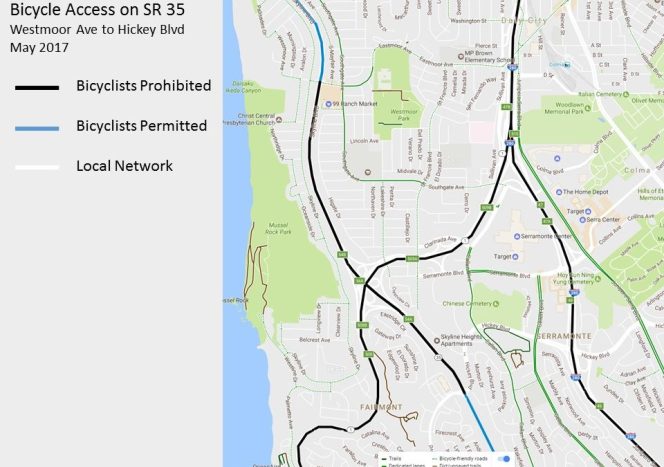There's no denying that the State Route 35 freeway interchange with State Route 1 is not the most comfortable place to ride a bike. Two lanes in both directions, barely a shoulder in places, and automobiles continually speeding. A cyclists was killed in the area two years ago, although it is unclear who was at fault.
Caltrans wants to make this intersection safer. So did they propose protected bicycle lanes? Some kind of ramp complex to separate bikes from cars, such as San Francisco did with the hairball?
Their solution was relayed to Streetsblog's tips email by reader and bike commuter Brian Coyne, who commutes a couple of times a week by bike from San Francisco to Palo Alto, via Skyline:
Caltrans District 4 is considering banning bikes from a section of Skyline Boulevard (CA-35) in Daly City, through the CA-1 interchange. Yesterday Sergio Ruiz, D4's bike coordinator, announced, through a rather casual email sent to various bike forums, that the ban was already a done deal and that signs banning bikes would be posted within a few weeks. There was no public outreach or opportunity for public comment.
Skyline is a busy road with fast traffic, and this stretch in particular I wouldn't take a novice rider through, but it's lots of people's commutes to work, and alternate routes involve extra distance and steep hills. And, of course, a ban on bikes as a "solution" to a bike safety issue is just totally unacceptable.
The Silicon Valley Bicycle Coalition (SVBC) created a Strava "heat map" to give a sense of where people ride in the area. In other words, hard data--and it shows that cyclists do indeed use this part of Skyline. Closing it to cyclists as a safety solution makes about as much sense as closing it to cars and making automobiles take a diversion.
In fact, perhaps it makes more sense to divert cars, since hills are less of a problem if you're propelled by an engine instead of your legs. From an SVBC blog post that included a list of objections from its members to the diversion, which they say is:
- very steep and requires a lot of climbing
- includes some tricky left turns from multilane roads and intersections
- out of the way
- includes several turns requiring a lot of signs for people to follow
For more on the diversion, check out this post on the Cyclelicious blog.
Meanwhile, the SVBC and others are asking bicycle advocates to email Sergio Ruiz, Sergio.ruiz [at] dot.ca.gov to request the following:
- A reversal of the decision to prohibit bicyclists on this segment of Highway 35.
- Interim improvements that would make the SR 35/SR 1 interchange safer for people biking, including maintenance of the existing shoulder.
- A longer-term design process looking at bicyclist access and safety on Highway 35.
SVBC also wants people to take the Caltrans District 4 bike survey.
That survey is part of a Caltrans policy objective to triple bicycle use on state highways by 2020. Please forgive Streetsblog for stating the screamingly obvious, but it's hard to reconcile this policy goal with banning biking on one of the more popular state-highway bicycle routes. Despite many livability initiatives in recent years, Caltrans remains an organization with serious pockets of bureaucratic contradiction and inertia.
"I’d like to emphasize that the proposed ban is just an option we are examining," said Robert Haus, Public Information Branch Chief for Caltrans District 4. "We are always looking for new ways to improve safety. No decision has yet been made. "
But it seems clear from sources inside and outside Caltrans that this is only the case because of the warning Ruiz posted that the ban was coming. "Ruiz is just a really good liaison," said Emma Shlaes, policy manager for the SVBC, "whenever something's going on I reach out to him."
For now, between Ruiz, other sympathetic people at Caltrans, and the advocates writing in, the bike-ban is now in stasis, awaiting more discussion, explained Shlaes. She's hoping that, if Caltrans can come around, a process will start for developing a truly safe interchange that will accommodate and protect bicycles.
As for Coyne, he's just annoyed at the whole attitude exemplified by Caltrans' approach. "What would you do if you're banning cars on a road? You'd do years of outreach and meetings. But a bike ban--staff does it, with no outreach, no public output...they already sent the order for bike ban signs."
Fortunately, the word got out before the signs got installed. Let's hope advocates can do more than just reverse this ridiculous ban proposal and start working on making this a high-quality, safe route for cars and bikes.






